Disclosure: if you purchase through any links on this web page, I earn referral fees from partners. These fees do not influence my recommendations.
Review summary:
To be honest, I expected much more for the price. As things stand, I believe that WP Engine is extravagantly overpriced.
Server performance is great, to be sure, but it isn’t better than what cheaper providers like WPX or SiteGround offer.
The fact that WP Engine does not sell domains or allow you to send emails are significant drawbacks for the average user.
Watch out for the monthly visitor limit – you are far more likely to hit that before you surpass your bandwidth quota and additional visits beyond the limit cost extra.
Live chat is good, but queue times can get quite long during peak-traffic hours.
Hosting prices (per month):
| Startup | Growth | Scale | |
|---|---|---|---|
| Monthly term | $30 | $115 | $290 |
| Annual term | $25 | $95.83 | $241 |
| Websites | 1 | 10 | 30 |
| Monthly visits | 25,000 | 100,000 | 400,000 |
| Disk space | 10 GB | 20 GB | 30 GB |
| Data transfer | 50 GB / mo | 200 GB / mo | 400 GB / mo |
Committing to the annual term will save you between 14% and 17% in costs when compared to the monthly term, depending on the plan.
As is the case with other popular WordPress hosting providers, WP Engine offers the same price on their first term as they do on renewals. They also don’t sell two- or three-year subscriptions.
If you’re in the market for a cheap annual plan, refer to these rankings: cheapest annual hosting plans.
What does the above translate to in terms of cost per website?
By dividing the monthly cost of an annual plan by the total number of websites allowed under that plan, I came up with the monthly cost of hosting a single website with WP Engine:
| Websites | Cost per site | |
|---|---|---|
| Startup | 1 | $29.16 |
| Growth | 10 | $9.90 |
| Scale | 30 | $8.05 |
Overall, this is very expensive for a shared hosting environment. For comparison, WPX Hosting charges up to 70% less per site you host with them.
Are there custom plans available?
Yes, WP Engine offers a custom plan, which they set up on a dedicated server. The pricing will depend on your requirements.
Although their website lists 25 as the number of websites you can have on a custom plan, a sales specialist told me that you can have as many websites as you’d like, with the cost of adding websites between $15-$20 per site.
Does WP Engine offer student hosting?
As of April 2019, WP Engine does not offer reduced rates for students. If you are an active student and have access to an .edu email account, see our best student hosting rankings.
Does WP Engine offer public discount promo codes?
Some hosting providers, such as WPX, provide public discount codes that allow new members to try out the service at a reduced initial price.
I asked WP Engine’s pre-sale team for promo codes and, unfortunately, none were available as of April 2019.
What payment methods are available at WP Engine?
One downside to WP Engine is that they only accept credit cards – PayPal is currently not supported.
Is WP Engine’s price negotiable?
Currently, negotiations are only possible for WP Engine’s “Custom” WordPress plans.
Please see our best hosts with negotiable prices rankings for more.
WP Engine hosting resources and restrictions
How much data transfer (bandwidth) do you get?
| Websites | Monthly bandwidth | |
|---|---|---|
| Startup | 1 | 50 GB |
| Growth | 10 | 200 GB |
| Scale | 30 | 400 GB |
That’s decent, but whether it’s enough or not will depend on your website’s average page size and average traffic.
To learn more, see my article on estimating a website’s bandwidth usage.
If you regularly exceed your bandwidth limits, WP Engine will not take your site down. Instead, they will reach out and ask you to upgrade your plan. This is fairly standard practice.
However, the bandwidth limits are not the problem at WP Engine – it’s the allowed monthly visits limit that’s cause for concern.
What happens if you exceed WP Engine’s allowed monthly visits?
In addition to bandwidth limits, WP Engine limits the number of unique visitors your websites can serve per month:
| Websites | Monthly visits | |
|---|---|---|
| Startup | 1 | 25,000 |
| Growth | 10 | 100,000 |
| Scale | 30 | 400,000 |
If you exceed the total unique visits limit, you’ll be charged $2 per 1,000 additional visits.
For example, if you’re on the Startup plan and your website receives 45,000 unique visits per month, you’re 20,000 visits over the limit. This will set you back 20 * $2 = $40, in addition to the base $29.16 you’re paying for hosting, putting your total expenditures at almost $70 per month.
Overall, I dislike seeing caps on the number of unique monthly visitors because there’s nothing you can do about them. With bandwidth limits, at least you can work on reducing the size of your pages and improving caching to serve more users using your existing resources.
How much storage space do you get with WP Engine?
| Websites | Disk space | |
|---|---|---|
| Startup | 1 | 10 GB |
| Growth | 10 | 20 GB |
| Scale | 30 | 30 GB |
Whether this will be enough will depend on your specific needs. Please see my recent article on WordPress website storage requirements for more.
Is there a limit on the number or size of MySQL databases?
A big drawback to WP Engine is that they only allow one MySQL database per website. This means that you can’t set up your own site analytics (such as Matomo) because it requires a separate database to run.
As for the size, there’s generally no limit on how big your databases can get, but if it goes beyond 2 GB, expect a “technical discovery conversation” with an engineer who will work with you to improve the performance of your database.
See our article on how big your website’s MySQL database can get.
Do subdomains count towards your plan’s website quota?
Yes, they do – WP Engine’s system does not differentiate between a top-level domain (such as example.com) and a subdomain (such as subdomain.example.com).
Unless you plan to activate the WordPress Multisite (WPMU) feature, which costs $20/month at WP Engine and adds complexity, you should assume that each subdomain will occupy a slot in your plan’s allowed sites quota.
Looking to host multiple WordPress sites affordably? See the WordPress section on our cheap hosting with unlimited domains page.
Is there an inode limit at WP Engine?
An inode limit denotes the number of folders, sub-folders, and files that you can store on your hosting account.
As of early 2019, WP Engine does not impose such a limit. I will update this review if this changes.
Check out our guide to hosts with the highest Inode limits for more recommendations.
How many emails can you send from WP Engine?
Yet another major drawback is that WP Engine doesn’t allow you to send emails at all.
WP Engine is strictly a hosting provider. Their servers are configured to only handle automated WordPress emails (notifications, admin password resets, etc.).
However, if you’re planning on having an e-mail address such as [email protected], you won’t be able to create one – you’ll need a third-party email hosting provider for that, in addition to your WP Engine website hosting.
Does WP Engine limit which WordPress plugins you can install?
They do. In an effort to maintain the integrity of their systems and maintain performance for all users, they enforce a plugin blacklist.
Some of the more popular plugins excluded by WP Engine include:
- WP Super Cache
- W3 Total Cache
- WordFence
- WP DB Manager
- Broken Link Checker
And many more – check out their disallowed plugins page for a complete list, along with reasons for the exclusion.
In most cases, the exclusions should not be a problem. For example, you shouldn’t need any caching plugins because WP Engine’s servers handle caching for all websites by default.
I installed one of the blacklisted plugins (Broken Link Checker) to see how WP Engine would respond. Within hours, I received the following email:
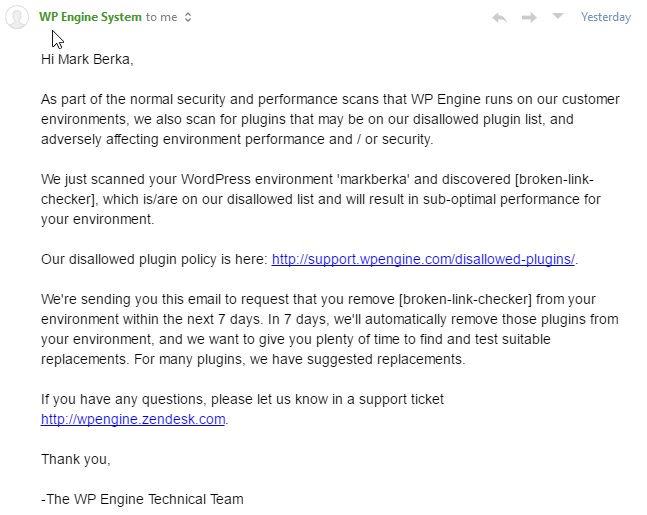
As you can see, they gave me seven days to delete the offending plugin before they would remove it automatically.
WP Engine user interface and usability
How easy is it to install WordPress on WP Engine and to perform other routine website management operations? Let’s find out.
Does WP Engine offer cPanel?
WP Engine does not offer cPanel. Instead, they use their own proprietary control panel. Here’s what the main website management view looks like:
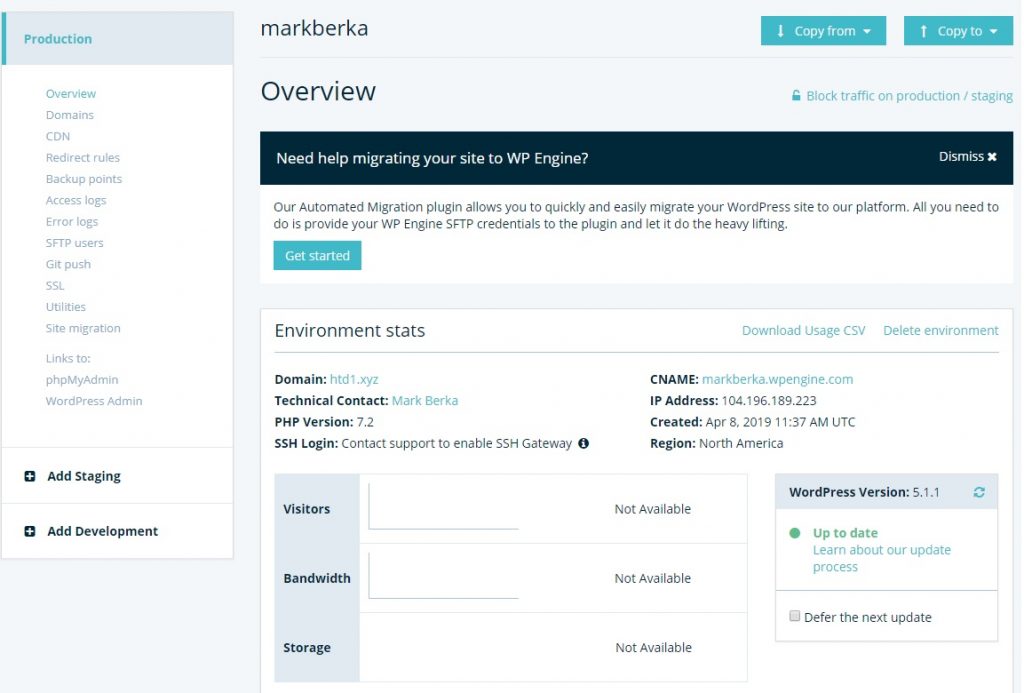
Through this backend, you can:
- Install, buy, and import SSL certificates
- Add new domains to your website
- Enable and disable CDN
- Set up redirect rules
- Manage, create, and restore backups
- Access server activity and error logs
- Create sFTP accounts
- Perform website migrations
- Access phpMyAdmin for MySQL database management
The backend offers a lot of functionality while remaining relatively user-friendly, although it took me 10 minutes to get used to it.
Adding a new domain/website to WP Engine:
To add a domain, log into your account and choose Domains from the left menu, followed by Add domain:
After you add a domain, you’ll need to log into your domain registrar and add a new A Record and CNAME record using the information provided under the Overview tab in your WP Engine account. This process is straightforward but can be intimidating for beginners, so make sure to use WP Engine’s detailed tutorial for this.
Installing a WordPress website on WP Engine
At WP Engine, WordPress is installed by default when you add a new website – no additional steps necessary.
Not that installing WordPress was ever a problem, but automatic installation was a nice touch and reinforced the fact that they are a WP-only hosting provider.
Managing files at WP Engine
To manage your hosted files at WP Engine, you’ll need to create an sFTP username (from the sFTP users menu) and then use your new credentials to access your server using any of multiple free FTP tools, such as Filezilla.
Additionally, WP Engine offers Secure Shell (SSH). As of early 2019, this feature was only available for certain plans, but a tech support representative told me that SSH access will be available to all users around May 2019 by default.
I did not see a built-in File Manager in the WP Engine control panel.
Website Load Speed Test
As multiple reports, including this one, have consistently shown, websites that load slowly are abandoned by more users.
For example, a website that takes five seconds to load could be abandoned by as many as 38% of visitors before the page even loads in their browser.
To test how quickly a WordPress site hosted with WP Engine loads, I set up a dummy test page that was:
- 2 MB large – that was the average size of a web page in 2018, according to MatchMetrics
- Required around 80 HTTP requests to load
I then used GTMetrix to check the website’s load time once per hour for almost an entire day, for a total of 22 speed checks:
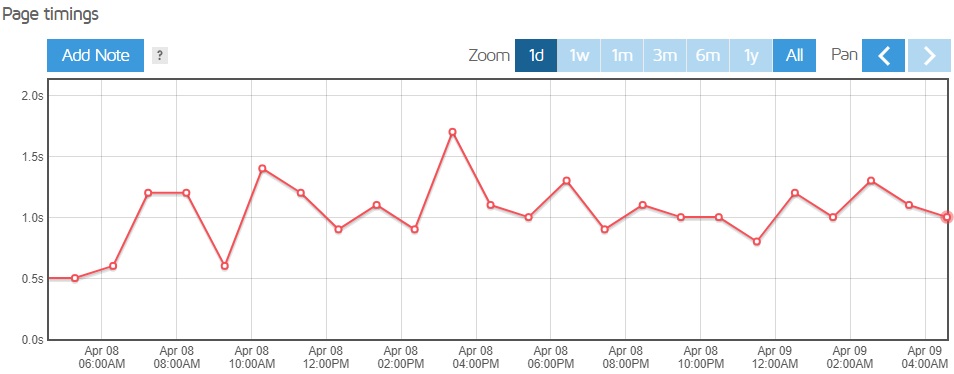
Overall, the average load time was around 1 second. The minimum was 0.5 and the maximum recorded was 1.6 seconds.
These are excellent load times, but considering the premium price, I was quietly expecting to be blown away. Instead, the WP Engine website loaded a little slower than my test site at WPX Hosting, despite the latter costing a fraction of the former.
How do WP Engine servers handle traffic spikes?
As always, I used LoadImpact to conduct a traffic spike simulation. The goal was to see if the server performs well even when experiencing high traffic.
And here’s a screenshot summary:

The blue line, which indicates the server’s response rate, remained almost completely flat (stable) throughout the test, at an average of 25 milliseconds.
This is definitely exceptional performance and indicates that we’re dealing with a properly optimized server with excellent resource management.
Overall, if your websites regularly serve dozens or hundreds of visitors simultaneously, you can feel confident that your users won’t experience poor server performance when traffic spikes.
WP Engine Hosting safety and security
Backups, malware prevention, and account security – is your sensitive data in good hands with WP Engine?
Does WP Engine offer free website backups?
Backups (called checkpoints) are created automatically every 24 hours and are stored on external servers. This means that automated backups do not use up your hosting plan’s storage capacity.
Backups are stored for 40 days and you can restore them for free with a few clicks.
You can also create manual backups at any time. Manual backups are stored locally on your own server and therefore take up storage space.
I recorded a short video showing how you can restore and create backups:
In my case, restoring a backup of my very basic, one-page test WP website took around one minute.
See our list of hosting providers with free backups and restorations for more recommendations.
WP Engine’s automatic malware scans
WP Engine’s malware prevention policy leaves a bit to be desired.
For starters, their automatic malware scanning is limited in scope. They use “proprietary in-house scanning systems,” as a tech operator told me, which does not detect as many infections as some of the popular commercial server antivirus systems do.
If you believe that your website has been infected, you need to contact WP Engine’s support. They, in turn, will reach out to Sucuri – a website security company owned by GoDaddy.
Sucuri will carry out a free malware scan of your website and fix/remove any malicious software they find.
Overall, good on WP Engine for not charging additional fees for scanning or malware cleanup, but I wish the entire process was more automatic and didn’t require me to keep an eye out for potential infections.
Read my guide to the top hosts that detect and remove malware for free.
Is 2-Factor login authentication (2FA) available?
Yes – you can enable two-factor admin login from the My Profile page, as I show here:
You’ll need to download Google Authenticator for your smartphone and scan the QR code to activate two-step authentication.
Once you enabled 2FA, you’ll need to provide a one-time code generated by the Authenticator app, in addition to your regular password, to log in to your WP Engine control panel.
How many failed login attempts does the system accept?
As usual, I wanted to see how many times I could try logging into my hosting account using an incorrect password before the system would lock me out.
I started recording a video of the process, but after around 20 incorrect login attempts I still didn’t see a “time out” message on the log-in screen.
However, when I attempted to log in using my correct password, I couldn’t. I checked my email and saw the following:
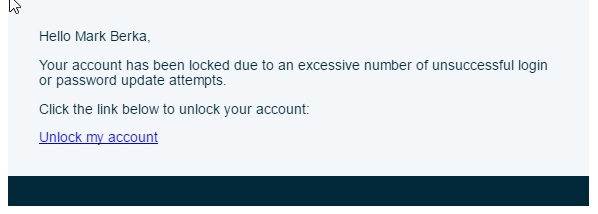
I clicked the Unlock my account link and was redirected to a special version of the log-in form, where I was able to access my account successfully after entering the correct password.
I thought it was cool that I only needed to click an emailed link to lift the account suspension – most hosts require you to undergo a verification procedure via Live Chat, which is time-consuming.
What if you forget your account password and lose email access?
I asked a tech representative what would happen in the case that I forgot my WP Engine account password and had no way of accessing my email to request a new password.
The technician first told me that I would need to undergo an extended legal process to regain access to my account. When I asked for more information, he consulted his superiors and came back with the following:
“WP Engine will require a valid order from a court of competent jurisdiction showing that you are the lawful owner of the account and should be granted administrative access. If such an order from a court is provided, this can be escalated for review to our Legal department.”
This is definitely more strict than in the case of other hosts, most of which will be happy to give you access back to your account if you email them scans of a photo ID. Whether this is good or bad, I’m not sure.
Additional services and freebies
Does WP Engine offer free SSL certificates?
WP Engine offers free LetsEncrypt SSL certificates for each website hosted with them. Here’s how you add a certificate after logging into your account:
Around 30 minutes after recording the video above, I received an email confirming that my certificate was installed.
Considering that other hosting companies install SSL certificates in a matter of 10-20 seconds, I was a bit surprised at the long wait involved here.
Do you get a free domain?
Unfortunately, WP Engine does not handle domains at all – they neither offer free nor paid domains, regardless of the plan you’re under.
As a result, you’ll need to register your domain with a domain registrar – NameCheap is a good choice.
Does WP Engine offer free website migration?
Yes and no – depending on your interpretation of “free migration.”
For Startup, Growth, and Scale Plans (shared hosting), you can download the WP Engine Automated Migration plugin and install it on the WordPress website you wish to migrate.
Then, under the plugin’s settings, you’ll need to enter the login credentials – you can find them under the Site migration tab in your WP Engine control panel:
A support operator told me that the average migration time using this plugin is 36 minutes, with 90% of migrations taking less than an hour. No website downtime is involved.
Alternatively, you can do a manual migration without using the plugin. This entails exporting a backup of your existing website and importing that backup through the WP Engine control panel. Their step-by-step instructions will guide you through the process:
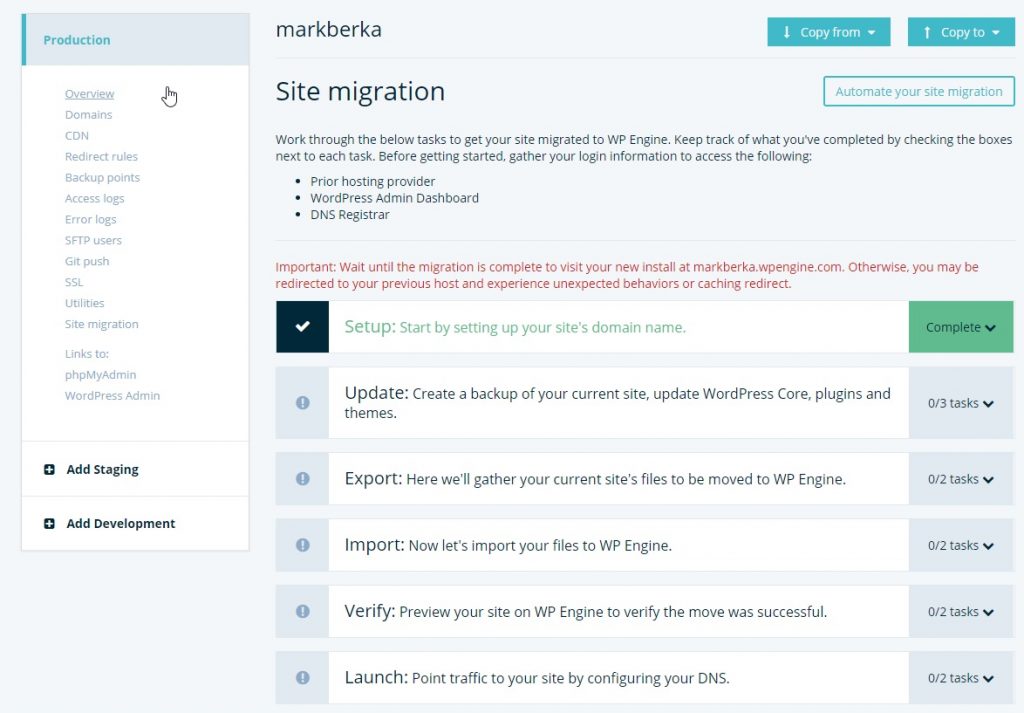
As you can see, in each case you are the one doing the migrating (either by installing and configuring the migration plugin or by exporting/importing your files), not an employee. So can we really call that “free migration” when other hosting companies will handle the process for you? I don’t think so.
However, if you are on their custom hosting (dedicated server), WP Engine staff will handle the migration process for you.
How safe is it to buy from WP Engine?
Does WP Engine offer a money-back trial period (and how to claim it)?
You can receive a full refund if you cancel within 60 days of your first hosting purchase. The refund is available for both monthly and annual terms. If you’re looking for longer refund guarantees, check out my article on the best hosts with long money-back policies.
To receive your money back:
Step #1: open the cancellation form, which you can find on the Modify plan page:
Step #2: request your refund in the Comments field. This part is critical: the message you type here will be forwarded to their Billing department. Unless you explicitly request a refund, you won’t receive it.
If you forgot to follow step #2 above, you have seven days from the day that your account is canceled to ask for your money back.
My own money-back request – step by step
After I was done with this review, I canceled my account using the form I showed on the video above.
A few seconds later I received an email confirming that a new Billing ticket had been created for my account, and an hour-or-so later I received this PDF:
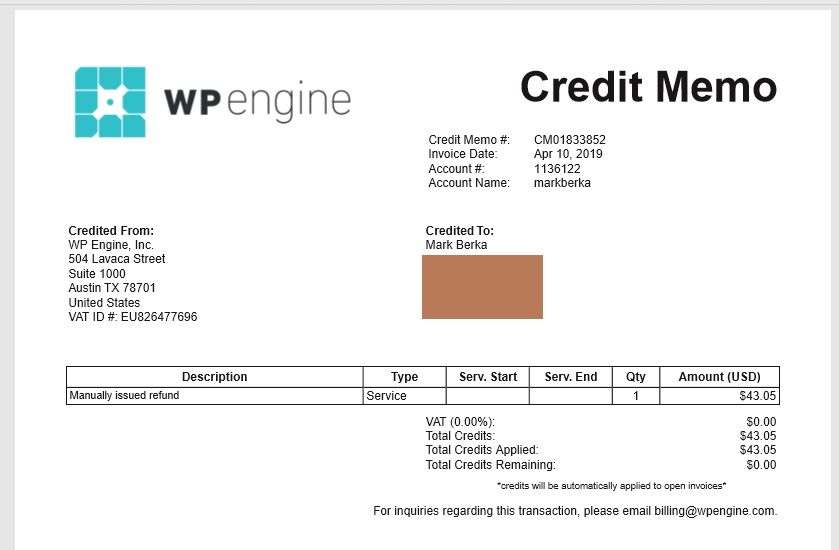
I was told it would take up to seven days for funds to show up on my credit card. I will update this review when I receive the funds.
Edit: the funds were refunded to my debit card two days later.
Does WP Engine offer refunds on unused subscription months (pro-rated refunds)?
Yes, they do. For example, if you pay for the annual plan and choose to cancel after six months, you’ll receive a refund for the months remaining under your plan – just make sure to request the refund within a week from cancelation.
One thing to keep in mind is that WP Engine’s annual plans are structured so that the last two months of hosting are technically free (you’re paying for 10 months of hosting + getting two months as a bonus).
This means that if you cancel after 10 months of being on the annual plan, you won’t be eligible for any refunds.
Make sure to check out our guide to pro-rated refund hosts.
WP Engine Hosting Content Delivery Network (CDN)
WP Engine partnered up with StackPath (formerly MaxCDN) to offer free CDN access to all users. In case you didn’t know, a CDN will help boost your website’s load speed and will reduce your server’s bandwidth usage, among other perks.
Here’s a list of all server locations that form this Network.
CDN is turned off by default – you can enable it under the CDN menu tab:
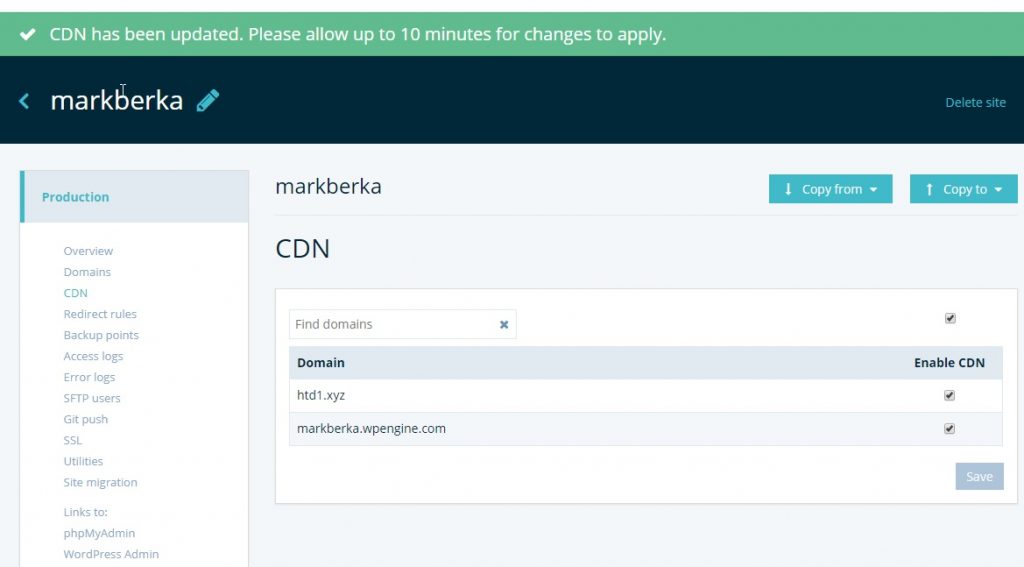
WP Engine WordPress Staging
WP Engine allows you to add a Staging for your WordPress website. A Staging is basically a clone of your original website that you can experiment on and modify without impacting the original site. Once you’re ready, you can deploy all changes to the Live website.
You can create one Staging per website. Here’s how to do it:
Around 10 minutes later, I received an email letting me know that my Staging was ready and accessible under berkastaging.wpengine.com.
The Staging has its own menu in the WP Engine control panel – you can assign domains to it, activate the CDN, create sFTP users, etc. – it’s basically seen by their systems as a separate website.
Note that the Staging occupies space on your hard drive, so if your original WordPress website is 3 GB large, creating a Staging will use up an additional ~3 GB (for 6 GB total).
Once you’re ready to copy your Staging site over to the main Live site, you just go to the Sites page, choose the Staging, and click the Copy to button:
Live chat support quality
WP Engine’s live chat team is available 24/7/365.
Presale chat support operators are only able to answer non-technical questions related to the company’s main offering and services.
Whenever I asked a technical question (for example, “is there a limit on the maximum size of a single MySQL database?”), I was put on a 5-minute hold while the operator consulted a technician.
Tech chat support is only accessible after you buy hosting and log into your account. The operators are knowledgeable and good communicators.
Unfortunately, queue times can get very long: while I was able to connect to a support agent in less than 2-3 minutes during early morning hours, late afternoon or early evening hours regularly saw me waiting 30-50 minutes for an available operator.
Overall good support, but I didn’t feel like they stood out from their competitors.

